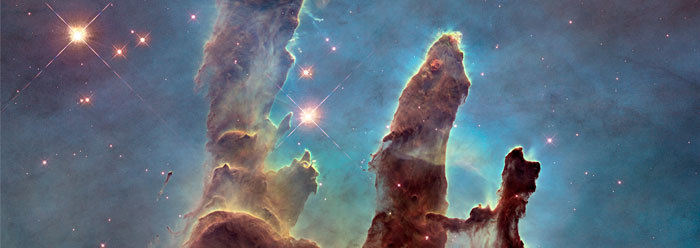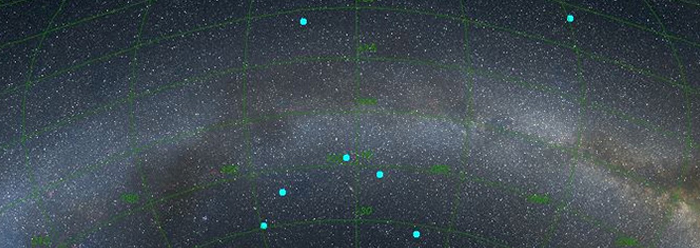In 1995 the Hubble Telescope photographed spectacular columns of gas, illuminated by nearby stars, in a section of the Eagle Nebula.1 The enormous columns of gas in this famous photo have been nicknamed "pillars of creation" since secular scientists insist that new stars are being "born" within them.
In celebration of the Hubble Telescope's 25th anniversary, a new photograph was taken of the same region in the Eagle Nebula, but this time the image was captured in both visible and infrared light, in order to reveal more detail.2 As before, secular astronomers are claiming that this area is a "stellar nursery" in which new stars are being born. However, although stars have been observed explosively shedding large amounts of material in nova and supernovae events, the birth of a star has never been observed—not even once.
If stellar birth has never actually been observed, why do secular astronomers claim that the Eagle Nebula is a stellar nursery? They do so for several reasons. First, dense gas pockets called evaporating gas globules (EGGs) are found at the tips of finger-like projections that extend from these gas columns.1 Some stars are seen inside these EGGs, and secular scientists interpret these as newly-formed stars. But secular scientists have not actually observed new stars being born; they have simply concluded that stars within the EGGs are new, based upon their ideas of star formation.
Second, gas pockets of high density are expected to result from secular star formation scenarios. For instance, it is claimed that radiation from nearby stars (or shock waves from nearby supernovae explosions) can compress the gas so that gravity "takes over," further compressing the gas enough to birth a star as nuclear fusion begins.3 Since this compression should result in gas pockets of higher density, EGGs are sometimes claimed to result from this process of star birth.4
But there are three big problems with this second argument. First, these pockets of high density are not necessarily new, but could just as easily have been present all along and were simply left behind as radiation "boiled away" the less dense surrounding gas. In fact, this is precisely the explanation given in the original 1995 Hubble press release.1 Worse yet, this scenario cannot explain the ultimate origin of stars, since it requires other stars to already exist! Finally, even if one ignores this obvious difficulty, there are enormous additional theoretical problems with secular star formation scenarios.5
The third reason for claiming this is a stellar nursery is that the stars in the nebula are quite massive, and massive stars should exhaust their nuclear fuel within just a few tens of millions of years. But the stars are still there, burning brightly, even though secular astronomers claim that the universe is billions of years old. Ergo, these stars must have been "born" recently!
But given the lack of observational evidence for star birth and the above problems with star formation scenarios, it seems extremely unlikely that the stars in the Eagle Nebula could actually have been formed recently. However, there is another possibility: Perhaps the reason for the continued existence of these relatively short-lived stars is because the universe is only thousands of years old—not millions!
Furthermore, given that these nearby stars are blowing away the Eagle Nebula's gas relatively quickly, it seems a remarkable coincidence to the secular astronomers that we would be lucky enough to observe it before it completely dissipated. Said astronomer Paul Scowen, "I'm impressed by how transitory these structures are…. We have caught these pillars at a very unique and short-lived moment in their evolution."2
Perhaps it is just a coincidence. But then again, we have also been "lucky" enough to observe many other transitory astronomical features having maximum possible lifetimes of only millions of years. The surprising cleanness of Saturn's rings (despite supposed billions of years of darkening by comet and asteroid dust) and the persistence of significant geological activity on Saturn's moon Enceladus (despite the fact that the heat needed to power this activity should have dissipated after millions of years) are both surprising in a universe that is allegedly billions of years old; but they are expected in one that is just 6,000 years old.6
Many other examples could be cited.7,8,9 In fact, secular scientists have acknowledged that such coincidences seem highly improbable and actually make them, in their own words, "uncomfortable."10 Have we just been incredibly lucky to observe all these short-lived phenomena? Or do we simply live in a very young universe?
The heavens declare the glory of God (Psalm 19:1), even when secular astronomers claim otherwise: "For in six days the Lord made the heavens and the earth, the sea, and all that is in them (Exodus 20:11a)."
References
- Anonymous. 1995. Embryonic Stars Emerge from Interstellar "Eggs". HubbleSite Press Release. Posted on hubblesite.org November 2, 1995, accessed January 16, 2015.
- Chou, F. and R. Villard. Hubble Goes High-Definition to Revisit Iconic 'Pillars of Creation'. NASA News Press Release. Posted on nasa.gov January 5, 2015, accessed January 14, 2015.
- Greenstein, G. 2013. Understanding the Universe: An Inquiry Approach to Astronomy and the Nature of Scientific Research. Cambridge, Cambridge University Press, 379.
- Russell, R. 2010. What happens inside an EGG? Windows to the universe. Posted on windows2universe.org, last modified May 10, 2010, accessed January 16, 2015.
- Lisle, J. 2012. Blue Stars Confirm Recent Creation. Acts & Facts. 41 (9): 16.
- Hebert, J. 2013. Youthful Solar System Bodies Puzzle Evolutionary Scientists. Creation Science Update. Posted on icr.org February 13, 2013, accessed January 15, 2015.
- Coppedge, D. 2008. Iapetus: Youth in Black and White. Acts & Facts. 37 (6): 15.
- Thomas, B. 2012. Young-Looking Methane Lakes on Saturn's Moon. Creation Science Update. Posted on icr.org July 16, 2012, accessed January 15, 2015.
- Lisle, J. 2013. The Solar System: Jupiter. Acts & Facts. 42 (12): 10-12.
- McKee, M. 2013. Planetary science: Caught in the Act. Nature. 493 (7434): 592-596.
Image Credit: Copyright © 1995 and 2014 NASA/ESA/Hubble Heritage Team (STScI/AURA)/J. Hester, P. Scowen (Arizona State University). Adapted for use in accordance with federal copyright (fair use doctrine) law. Usage by ICR does not imply endorsement of copyright holder.
* Dr. Hebert is Research Associate at the Institute for Creation Research and received his Ph.D. in physics from the University of Texas at Dallas.
Article posted January 19, 2015.

























